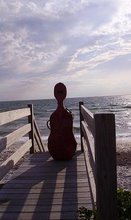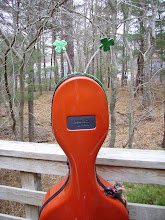
I "met" Scottish folk cellist Seylan Baxter through this blog a couple of years ago when she commented on my posts about attending Scottish fiddle camp. She sent me a copy of her cello and harp CD, "2:40" (with harpist Cheyenne Brown, originally from Alaska, but now living in Scotland), and I was an immediate fan. The name of the CD refers to the 2 performers, and the 40 strings they play.
So, when I learned they would be relatively close, at the Blackstone River Theatre in Cumberland, Rhode Island, on their first U.S. tour, I drove the 70 miles to see them. It was a dark and stormy night, and I could barely find my way home through the torrential rains after the show, but it was a concert well worth seeing; I loved every minute of it.
I find it hard to describe Scottish folk music; it is fiddle music, Celtic music, but with an earthiness to it (perhaps the cello), a solidness and rustic flavor that appeals to me. The cello and harp are not a traditional instrumental duo, and the cello is not traditionally a solo instrument in Scottish music, but Seylan and Cheyenne make you believe that these two instruments, and Scottish music, belong together, and that the cello clearly deserves a starring role. The two instruments, the two young women, share the musical spotlight, and they were quite amiable and congenial as performers. In addition to playing the cello, Seylan sings; she has a wonderful voice, especially good for ballads.
I talked to them both after the show, and they said they hope to return next year for another U.S. tour. The Cumberland audience was wildly enthusiastic about their playing, and I think U.S. audiences will be very happy to see them again.
Seylan uses many contemporary techniques in her cello playing, chopping, rhythmic slapping of the wood, sliding up and down the string, pizzicato, and more. Seylan started out as a classical cellist, switching to Scottish folk music while in college. She did not learn by ear immediately, and had to work on that skill. She encouraged me in my continuing efforts to learn by ear. She was doing a cello workshop the day after the concert in Arlington, MA, and I wish that I had been able to attend (I had a fiddling commitment of my own and another concert to attend). Maybe next year!
The first think you notice about her playing is, of course, that she plays standing up, her cello balanced on a chair. Cheyenne stands as well, her harp elevated a few inches to make this possible. I talked to Seylan about the standing, and asked why she played that way, and whether it was difficult. She said she started doing it because she was often the only one sitting. She experimented with different methods, including strapping on an electric cello, but using a chair turned out to be the easiest thing to do. Some other fiddlers use a longer end-pin or other methods.
Not believing her, I gave it a try at home. It is easy to play this way, and I think the sound is more voluminous. Could be just from where I was in relationship to the cello, but I asked my husband for his opinion, and he agreed that I had a bigger sound when I was standing. I might have to explore this further.
It was a great concert; it was wonderful to see and hear Seylan and Cheyenne, and I hope they expand their tour next year to include a Cape Cod venue and cello workshop. There was one cellist (me) and one harpist in the audience in Rhode Island, and I think there would be many more of each on the Cape.
I am glad to have discovered the Blackstone River Theatre, a small 100-seat theater that offers a folk concert series, mostly Celtic music. I hope to go back again on December 5, when the Jeremy Kittel Band is playing. I have actually never heard of them, but cellist Tristan Clarridge plays with this group. (He is also in Crooked Still, another alternative folk, bluegrass group I enjoy.)











